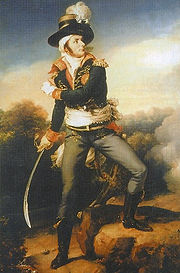
François de Charette
Encyclopedia

France
The French Republic , The French Republic , The French Republic , (commonly known as France , is a unitary semi-presidential republic in Western Europe with several overseas territories and islands located on other continents and in the Indian, Pacific, and Atlantic oceans. Metropolitan France...
soldier and politician, one of the leaders of the bloody events termed the "Revolt in the Vendée
Revolt in the Vendée
The War in the Vendée was a Royalist rebellion and counterrevolution in the Vendée region of France during the French Revolution. The Vendée is a coastal region, located immediately south of the Loire River in western France. The uprising was closely tied to the Chouannerie, which took place in...
". His relative Athanase-Charles-Marie Charette de la Contrie was a noted military leader.
Early activities
A noblemanFrench nobility
The French nobility was the privileged order of France in the Middle Ages and the Early Modern periods.In the political system of the Estates General, the nobility made up the Second Estate...
born in Couffé
Couffé
Couffé is a commune in the Loire-Atlantique department in western France.-See also:*Communes of the Loire-Atlantique department...
, arrondissement of Ancenis
Arrondissement of Ancenis
The arrondissement of Ancenis is an arrondissement of France, located in the Loire-Atlantique département, in the Pays de la Loire région...
, Charette served in the French Navy
French Navy
The French Navy, officially the Marine nationale and often called La Royale is the maritime arm of the French military. It includes a full range of fighting vessels, from patrol boats to a nuclear powered aircraft carrier and 10 nuclear-powered submarines, four of which are capable of launching...
under Toussaint-Guillaume Picquet de la Motte
Toussaint-Guillaume Picquet de la Motte
Count Toussaint-Guillaume Picquet de la Motte was a French admiral.Aged fifteen, he joined the navy as a midshipman and served in Morocco, the Baltic Sea, the Caribbean Islands and in India. Noted for his strategic skills, he was called to Paris in 1775 to help the Secretary of State prepare the...
, notably during the American War of Independence, and became lieutenant de vaisseau
Lieutenant
A lieutenant is a junior commissioned officer in many nations' armed forces. Typically, the rank of lieutenant in naval usage, while still a junior officer rank, is senior to the army rank...
. He quit the Navy in 1789 and emigrated
Émigré
Émigré is a French term that literally refers to a person who has "migrated out", but often carries a connotation of politico-social self-exile....
to Koblenz
Koblenz
Koblenz is a German city situated on both banks of the Rhine at its confluence with the Moselle, where the Deutsches Eck and its monument are situated.As Koblenz was one of the military posts established by Drusus about 8 BC, the...
(Trier
Trier
Trier, historically called in English Treves is a city in Germany on the banks of the Moselle. It is the oldest city in Germany, founded in or before 16 BC....
) in 1792 (a common move for royalist
House of Bourbon
The House of Bourbon is a European royal house, a branch of the Capetian dynasty . Bourbon kings first ruled Navarre and France in the 16th century. By the 18th century, members of the Bourbon dynasty also held thrones in Spain, Naples, Sicily, and Parma...
aristocrats). He soon returned to France to live at his property in La Garnache
La Garnache
La Garnache is a commune in the Vendée department in the Pays de la Loire department in the Pays de la Loire region in western France.-References:*...
, and became one of those defending King Louis XVI
Louis XVI of France
Louis XVI was a Bourbon monarch who ruled as King of France and Navarre until 1791, and then as King of the French from 1791 to 1792, before being executed in 1793....
and Marie Antoinette
Marie Antoinette
Marie Antoinette ; 2 November 1755 – 16 October 1793) was an Archduchess of Austria and the Queen of France and of Navarre. She was the fifteenth and penultimate child of Holy Roman Empress Maria Theresa and Holy Roman Emperor Francis I....
from physical harm during the mob attack on Tuileries Palace
Tuileries Palace
The Tuileries Palace was a royal palace in Paris which stood on the right bank of the River Seine until 1871, when it was destroyed in the upheaval during the suppression of the Paris Commune...
(the Journée du 10 août
10th of August (French Revolution)
On 10 August 1792, during the French Revolution, revolutionary Fédéré militias — with the backing of a new municipal government of Paris that came to be known as the "insurrectionary" Paris Commune and ultimately supported by the National Guard — besieged the Tuileries palace. King Louis XVI and...
); arrested in Angers
Angers
Angers is the main city in the Maine-et-Loire department in western France about south-west of Paris. Angers is located in the French region known by its pre-revolutionary, provincial name, Anjou, and its inhabitants are called Angevins....
, he was released through the intervention of Charles François Dumouriez
Charles François Dumouriez
Charles-François du Périer Dumouriez was a French general during the French Revolutionary Wars. He shared the victory at Valmy with General François Christophe Kellermann, but later deserted the Revolutionary Army and became a royalist intriguer during the reign of Napoleon.-Early life:Dumouriez...
.
Insurrection
In 1793, the Revolt in the VendéeRevolt in the Vendée
The War in the Vendée was a Royalist rebellion and counterrevolution in the Vendée region of France during the French Revolution. The Vendée is a coastal region, located immediately south of the Loire River in western France. The uprising was closely tied to the Chouannerie, which took place in...
against the First French Republic broke out, and the peasant fighters asked Charette to be their leader. He joined Jacques Cathelineau
Jacques Cathelineau
Jacques Cathelineau , nicknamed le Saint d'Anjou , was a French Vendéan insurrection leader during the French Revolution...
and fought in most of the battles of the Armée catholique et royale. After the parting of the Vendean leaders in September 1793, he and his men retreated. He became the leader of the Lower Vendée, and successfully used guerilla warfare against the Republican troops, even managing to capture a Republican camp in Saint-Christophe-du-Ligneron
Saint-Christophe-du-Ligneron
Saint-Christophe-du-Ligneron is a commune in the Vendée department in the Pays de la Loire region in western France.-References:*...
, near Challans
Challans
Challans is a commune in the Vendée département in the Pays de la Loire région in western France....
, but ran out of supplies and was decisively attacked by the troops of Nicolas Haxo.
Defeat
On the 17 February 1795, near VertouVertou
Vertou is a commune in the Loire-Atlantique department in western France.It is located on the River Sèvre Nantaise, and was a historical town of Brittany....
, Charette signed a peace treaty with the emissaries of the National Convention
National Convention
During the French Revolution, the National Convention or Convention, in France, comprised the constitutional and legislative assembly which sat from 20 September 1792 to 26 October 1795 . It held executive power in France during the first years of the French First Republic...
, which included freedom of religion
Freedom of religion
Freedom of religion is a principle that supports the freedom of an individual or community, in public or private, to manifest religion or belief in teaching, practice, worship, and observance; the concept is generally recognized also to include the freedom to change religion or not to follow any...
guarantees and excluded the conscription of local peasants from the levée en masse
Levée en masse
Levée en masse is a French term for mass conscription during the French Revolutionary Wars, particularly for the one from 16 August 1793.- Terminology :...
. The republicans nakedly broke the terms of the treaty, and their parole
Parole
Parole may have different meanings depending on the field and judiciary system. All of the meanings originated from the French parole . Following its use in late-resurrected Anglo-French chivalric practice, the term became associated with the release of prisoners based on prisoners giving their...
, going back on the guarantees of religious freedom and began conscripting the peasants once again. They also murdered thousands of royalist prisoners including the Bishop of Dol
Dol-de-Bretagne
Dol-de-Bretagne , cited in most historical records under its Breton name of Dol, is a commune in the Ille-et-Vilaine département in Brittany in north-western France.-History:...
. Charette and his men returned to the fight again in July and moved to help the planned invasion at Quiberon
Quiberon
Quiberon is a commune in the Morbihan department in Brittany in north-western France.It is situated on the southern part of the Quiberon peninsula, the northern part being the commune of Saint-Pierre-Quiberon...
by emigrated French royalists with assistance from the British
Kingdom of Great Britain
The former Kingdom of Great Britain, sometimes described as the 'United Kingdom of Great Britain', That the Two Kingdoms of Scotland and England, shall upon the 1st May next ensuing the date hereof, and forever after, be United into One Kingdom by the Name of GREAT BRITAIN. was a sovereign...
Royal Navy.
The Count of Artois
Charles X of France
Charles X was known for most of his life as the Comte d'Artois before he reigned as King of France and of Navarre from 16 September 1824 until 2 August 1830. A younger brother to Kings Louis XVI and Louis XVIII, he supported the latter in exile and eventually succeeded him...
, the Bourbon successor to the throne of France, made him Lieutenant General
Lieutenant General
Lieutenant General is a military rank used in many countries. The rank traces its origins to the Middle Ages where the title of Lieutenant General was held by the second in command on the battlefield, who was normally subordinate to a Captain General....
and gave orders to prepare for a royal return which, however, did not eventuate. Charette remained loyal to the old dynasty and the Catholic religion, as did his men and most of the Vendean and Breton peasantry. He, and all the loyal royalists, later refused to join the liberal
Liberalism
Liberalism is the belief in the importance of liberty and equal rights. Liberals espouse a wide array of views depending on their understanding of these principles, but generally, liberals support ideas such as constitutionalism, liberal democracy, free and fair elections, human rights,...
Orléanist
Orléanist
The Orléanists were a French right-wing/center-right party which arose out of the French Revolution. It governed France 1830-1848 in the "July Monarchy" of king Louis Philippe. It is generally seen as a transitional period dominated by the bourgeoisie and the conservative Orleanist doctrine in...
s. After the failure of the Quiberon expedition, Charette and his men were pursued by General Lazare Hoche
Lazare Hoche
Louis Lazare Hoche was a French soldier who rose to be general of the Revolutionary army.Born of poor parents near Versailles, he enlisted at sixteen as a private soldier in the Gardes Françaises...
. Charette was wounded but escaped. However he was eventually captured outside La Chabotterie and taken to Nantes
Nantes
Nantes is a city in western France, located on the Loire River, from the Atlantic coast. The city is the 6th largest in France, while its metropolitan area ranks 8th with over 800,000 inhabitants....
for a show trial. He was sentenced to death by a republican kangaroo court and then taken to the town square in procession for a public execution. He was shot by firing squad. A plaque has been erected and still stands upon the place where he was shot. Today memorial ceremonies continue to take place there.

